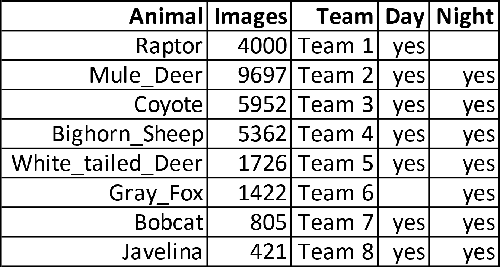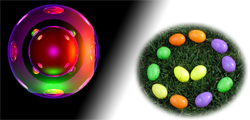Overview
In this assignment you are being asked to crowd source the task of extracting images of individual animals captured by remote wildife monitoring cameras. Note this assignment was dicussed at length in lecture today, March 27, so the instruction here are relatively brief.
In short, each of the eight project teams needs to select 200 good examples of their assigned animal. To do this each team should review the source images they are assigned and first select good images and then extract image chips highlighting an animal from each selected image. Teams will need to be selective since many of the raw images have very poor quality animal images and these very challenging examples are not where we want to start.
Source Data and Animal Labels
The data being used in this assignment is being providedd to us by biologists responsible for wildlife management on ranges managed by the Department of Defense. They are extending use of this data to us as a courtesy and for official use only. It is of interest to them, as well as to us, to explore the feasibility of automatic labeling of animals using modern machine learning in general and convolutional neural networks in particular. All students in CS510 granted the priveldge of working with this data must ensure the data is not in any manner publicly distributed. It is being provided solely for use in the context of CS510.
Out of a much larger data set of images hand labeled by biologists, a small subset has been assembled for the purpose of experimentation in CS510. Here is a table summarizing the animal labels involved, to which teams these animals are assigned, and a count of the number of raw files available from which to select image chips.

Making Image Chips
Each team is responsible for creating 200 image chips centered upon instances of the appropriate animals. These chips should be uploaded to a folder specified below. The chips must be square and a power of two pixels on a side. Unless there is a reason to make a bigger chip, the default shoulb be 64 pixels on a side. When needed, chips may be as large as 512 pixels on a side.
Please adhere strictly to the following naming convention. Suppose a chip is coming from the following image.
cs510bmgr_Wildlife_Water_N_0499_Bobcat_01_2014_04_27_20_11_50.JPG
Since this is an image acquired at night the chip name would be:
cs510bmgr_Wildlife_Water_N_0499_Bobcat_01_2014_04_27_20_11_50_chip01_night.JPG
The
chip01
designates it is the first animal chip from the larger source image.
In this assignment it will be rare to extract more then one chip from
a single image, but the generality is built into the naming
convention of anticiapation of such a need down the road. The
night
part designates this image as being taken at night. Daylight images
should include
day
instead.
Where is the Data
The source images are stored on the CS Unix system and can only be
read by members of the Unix group
vision
. Their exact path is
~vision/data/bmgr/cs510bmgr8
. Teams should upload their properly named image chips to the folder
~vision/data/bmgr/cs510chips
Evaluation
This assignment is pretty straight forward and so long as the 200 image chips are visually reasonable and delviered on time a team should receive full credit. If in doubt about what constitutes a good chip team members should as the instructor for guideance.
Addendum
To modify the directions above, to make all our lives easier and to better prepare for using existing CNNs lets settle on all image chips being square and 256 pixels on a side. (Ross 3/30/2019)

